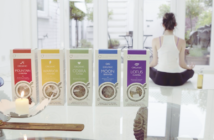Originally appeared in the 2013 July/August issue of Tea Magazine
Warm summer days inspire us to spend more time outdoors doing active things. While frolicking outside is undoubtedly fun, the truth remains that it’s good for us, too. Being in nature and increasing our exercise are known to significantly enhance our general health and wellness, bolstering body, mind, and spirit. Perhaps the only downside is the potential for scrapes and cuts, along with unwanted sunburn if we’re not vigilant applying our sunscreen.
But did you know that our beloved Camellia sinensis can help with healing these ailments when it is used in a poultice? Poultices are not necessarily quick and easy, yet these concoctions have been used with great success for centuries, building on a variety of bases to create customized treatments for all kinds of maladies. Given the anti-inflammatory and astringent qualities of tea, especially green tea, it only makes sense to use our favorite drink as an ingredient for treating any number of minor skin woes.
Download our free Wellness & Tea 101 E-Book
There are dozens, if not hundreds, of varieties of poultice, but they all stem from a few basic forms. In its simplest incarnation, there is the “spit poultice” to take care of a cut or scrape when you’re away from home without many resources other than your whole-leaf tea, which might be sitting patiently in your travel mug. Preparing a spit poultice couldn’t be simpler: just remove the leaves and chew them up a bit. Spit out the mash and voilà—you’ve got a green tea poultice. Apply the poultice, cover the area with a cloth or bandage, and you’re good to go. The antibacterial properties of the tea will do the job of Neosporin or other over-the-counter remedies, helping to protect and heal the wound. If you have the luxury of being home, then I’d suggest you make a warm poultice of minced tea leaves, again, placing it directly on the affected area. The warm concoction will help to draw out any infection. If you plan to keep the poultice on for a few hours, try covering the cloth with plastic wrap to keep the moisture in.
Scientists are now starting to confirm what herbalists and healers have known for centuries: green tea has amazing healing properties. Dr. Stephen Hsu, working in the area of Oral Biology at the Medical College of Georgia, reported remarkable evidence of green tea’s ability to reactivate dying skin cells. Looking specifically at EGCG, one of the star polyphenols found in green tea, he found that this free radical scavenger acted like a fountain of youth for skin cells. “Cells that migrate toward the surface of the skin normally live about 28 days, and by day 20, they basically sit on the upper layer of the skin getting ready to die,” Dr. Hsu said. “When exposed to EGCG, the old cells found in the upper layers of the epidermis appear to start dividing again. They make DNA and produce more energy. They are reactivated. There are lots of unknowns—this is the first step into the door—but if we can energize dying skin cells, we can probably improve the skin condition.”
If you’ve ever noticed that you tend to break out after getting some sun, you’ll be happy to learn that green tea is as effective in treating acne as the popular over-the-counter cream benzoyl peroxide. Working with a study of 100 subjects, Dr. Jennifer Gan-Wong of the Memorial Medical Center in the Philippines found that green tea was effective in reducing inflammation and redness while it detoxified the eruption and induced healing in the affected area.
There’s even interest in green tea for relieving radiation burns in those undergoing cancer treatments. In many cases, the surrounding skin is adversely affected by the radiation used during treatment. Dr. Frank Pajonk’s research involved applying poultices to the affected, burned areas. His team’s conclusions support the evidence of green tea’s ability to heal the skin from burns. According to the study, “Topically applied green tea extracts were clinically efficacious in the treatment of grade 2+ skin toxicity during radiation therapy. However, the underlying mechanisms are most likely complex and involve antibacterial and anti-inflammatory processes.”*
So if you were debating about bringing along some whole-leaf green tea along in a travel mug or pot on your next summer hike, beach excursion, or bike ride, this one’s a no-brainer. With one simple steeping, you can rehydrate yourself with a delicious tea drink and have the resources necessary to treat any minor cuts, scrapes, or burns that may arise.
*April 2003 Journal of Pharmacology and Experimental Therapeutics




